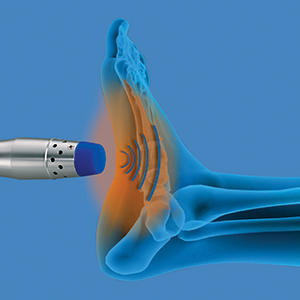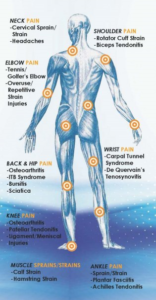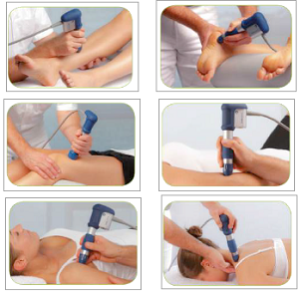Learn how Shock Wave Therapy breaks up scar tissue, increases blood flow, alleviates pain, and speeds up healing from Dr. Patrick Cho, Medical Director of Activation Clinic during his interview on Island Style with Taizo Braden.
What is Shock Wave Therapy?
Shockwave Therapy, also known as Extracorporeal Shock Wave Therapy (ESWT), is a clinically proven and highly effective treatment for chronic soft tissue injuries and certain bone conditions. If conservative treatments such as cortisone injections, anti-inflammatory medications, splints, braces, orthotics, or physical therapy have failed to relieve your pain or numbness, then ESWT may be right for you.
Shockwave Therapy or ESWT is also called Pressure Wave, Pulse Wave, or Sonic Wave Therapy.


How does Shock Wave Therapy work?
The effects of Shock Wave Therapy occur across several levels:
1. Cell Level Change – Shock wave stimulus affects the chemical environment of tissues at a cellular level. This causes changes to free radicals which boost the release of the substances that help to prevent pain and inflammation.
2. Break up of Scar Tissue – Unlike normal elasticated tissue, scar tissue is non-elastic and will prevent normal movement and function, thereby weakening the unaffected tissue surrounding it, often causing further damage and pain. Shock Wave Therapy breaks down fibrous scar tissue which builds up over time, especially with chronic conditions. By increasing circulation and breaking down scar tissue, Shock Wave Therapy will stimulate cell regeneration and promote normal healing and rapid reduction of pain. The normal function can then be restored.
3. Blood Flow Change – Normal blood flow is critical to the healing process. Shock Wave Therapy creates a revascularization effect. This type of stimulus redirects new blood flow into the affected area which improves soft tissue healing and regeneration.
4. Muscle Tone Modification – Shock Wave treatment adjusts the contractile activity of muscle and can also break patterns of neuro-cognitive pain that are associated with chronic conditions. This effectively relaxes muscles and reduces spasm, and has specific benefits with eliminating trigger points.
5. Pain Reduction – Shock Wave pulses directly affect the nerve fibers that transmit pain signals to our brain. Through the Gate Control Mechanism, Shock Wave Therapy impacts the interneurons in the A-β fibers which prevent the communication of pain.
6. Improved Nerve Function – In addition to vascularization and tissue regeneration, Shock Wave Therapy has been shown to promote nerve regeneration and help protect against neuropathy and neuronal degeneration.
Extracorporeal Shock Wave Therapy Treatment Areas
- Ankle / Foot Pain
- Plantar Fasciitis / Heel Spurs
- Achilles Tendinitis
- Hand/Wrist Pain
- Carpal Tunnel
- De Quervain’s Tenosynovitis
- Trigger Finger / Stenosis Tenosynovitis
- Shoulder Pain
- Rotator Cuff Strain
- Frozen Shoulder
- Biceps Tendinitis
- Neck Pain / Stiffness
- Cervical Sprain / Strain
- Headaches originating from neck pain
- Elbow Pain
- Tennis Elbow
- Golfer’s Elbow
- Pitcher’s Elbow
- Elbow overuse / strain
- Back & Hip Pain
- Bursitis
- Sciatica
- Piriformis
- Leg or Knee Pain / Stiffness
- Runner’s Knee –Iliotibial Band Syndrome / Patellofemoral Pain
- Shin Splints / Medial Tibial Stress Syndrome
- Patellar Tendinitis / Jumper’s Knee
- Ligament / Meniscal Injuries
- Chronic Tendinitis
- Calcification / Calcific Tendinitis
- Peripheral Neuropathy
- Trigger Points
- Scar Tissue Accumulation after surgery
Does Shock Wave Therapy hurt?
Most patients experience mild discomfort during treatment, but it is generally well tolerated. The initial discomfort typically fades as the area becomes desensitized as it is being treated.
How many treatments will I need?
Most conditions require SIX treatments at one-week intervals. However, more chronic or complicated conditions may require up to ten treatments.
How successful is Shock Wave? Are the results long-lasting?
Extracorporeal Shock Wave Therapy is one of the most widely researched rehabilitation modalities. There are THOUSANDS of peer-reviewed clinical studies on the use of shock wave therapy for the treatment of acute and/or chronic pain and/or neuropathy, with increasing numbers of scientific studies added each year. Research validates the effectiveness of Shock Wave Therapy, and shows successful treatment rates of up to 90%.
Extracorporeal Shock Wave Therapy has been used in Europe and Asia for many decades to address acute and chronic musculoskeletal pain and/or neuropathy. It is an effective, non-invasive, long-lasting alternative to pharmaceutical drugs or surgery. In most cases, with proper rehabilitation, the results of Shock Wave Therapy for muscle or joint pain can be permanent, so long as the target area is not reinjured. In cases of neuropathy or autoimmune conditions, the results of Shock Wave Therapy may not be permanent, but can alleviate symptoms and provide a significantly better quality of life.
To schedule a consultation with Dr. Cho, call us at (808) 379-2000 or or complete this form.
Is Shock Wave Therapy covered by health insurance?
Although Shock Wave Therapy is a clinically proven effective treatment for musculoskeletal pain, it is not covered by health insurance. The cost of Shock Wave treatment generally ranges from $1200 to $3500 per treatment area, depending on the severity of the pain or injury as well as the location. There is no downtime, no time bedrest required, and no side effects.
Some Activation Clinic patients share their experiences with Extracorporeal Shock Wave Therapy.
Research references:
- Treatment for insertional Achilles tendinopathy: a systematic review. Knee Surgery, Sports Traumatology, Arthroscopy. Jun2013, Vol. 21 Issue 6, p1345-1355.
- A single application of low-energy radial extracorporeal shock wave therapy is effective for the management of chronic patellar tendinopathy. Knee Surgery, Sports Traumatology, Arthroscopy. Feb2013, Vol. 21 Issue 2, p346-350.
- Conservative Management of Midportion Achilles Tendinopathy. Sports Medicine. 2012, Vol. 42 Issue 11, p941-967.
- Shockwave therapy for chronic Achilles tendinopathy: A double-blind, randomized clinical trial of efficacy. Acta Orthopaedica. Apr2008, Vol. 79 Issue 2, p249-256.
- Extracorporeal shock wave therapy in runners with a symptomatic heel spur. Knee Surgery, Sports Traumatology, Arthroscopy. Oct2006, Vol. 14 Issue 10, p1029-1032.
- Extracorporeal shock wave therapy promotes cell proliferation and collagen synthesis of primary cultured human tenocytes. Knee Surgery, Sports Traumatology, Arthroscopy. Dec2011, Vol. 19 Issue 12, p2159-2168.
- The Efficacy of Extracorporeal Shock-Wave Treatment: A New Perspective. Athletic Therapy Today. Nov2005, Vol. 10 Issue 6, p50-51.
- Long-term results of extracorporeal shockwave treatment for plantar fasciitis. Am J Sports Med 2006;34:592–6.
- Extracorporeal shock wave therapy for the treatment of plantar fasciitis. Foot Ankle Int 2004;25:290–7.
- Shock wave therapy for chronic proximal plantar fasciitis. Clin Orthop Relat Res 2001;47–59
- Shock wave application for chronic plantar fasciitis in running athletes. A prospective, randomized, placebo-controlled trial. Am J Sports Med 2003;31:268–75.
- Comparison of two extracorporeal shock wave therapy techniques for the treatment of painful subcalcaneal spur. A randomized controlled study. Clin Rehabil 2008;22:780–7.
- Extracorporeal shock wave treatment for chronic lateral epicondylitis (tennis elbow). Issues Emerg Health Technol 2007;96:1–4.
- Extracorporeal shock-wave treatment for tennis elbow. A randomised double-blind study. J Bone Joint Surg Br 2003;85:852–5.
- Extracorporeal shock wave therapy for the treatment of chronic calcifying tendonitis of the rotator cuff: a randomized controlled trial. JAMA. 290, 2573–2580 (2003).
- Nitric oxide mediates anti-inflammatory action of extracorporeal shock waves. FEBS Lett. 2005;579:6839–45.
- Shockwave treatment for medial tibial stress syndrome in athletes; a prospective controlled study. Br J Sports Med. 2012;46(4):253–257.
- Ultrasound and shock-wave stimulation to promote axonal regeneration following nerve surgery: a systematic review and meta-analysis of preclinical studies. Sci Rep. 2018 Feb 16;8(1):3168.
- Efficacy of Extracorporeal Shockwaves Therapy on Peripheral Nerve Regeneration. J Craniofac Surg. Nov-Dec 2019;30(8):2635-2639.
- The use of shock waves in peripheral nerve regeneration: new perspectives? Int Rev Neurobiol. 2013;109:85-98
- Extracorporeal shock wave treatment for shoulder calcific tendonitis: a systematic review. Skeletal Radiol. 2007;36:803–811.
- ESWT for tendinopathy: technology and clinical implications. Knee Surg Sports Traumatol Arthrosc. 2013;21:1451–1458.
- Evidence for effectiveness of Extracorporal Shock-Wave Therapy (ESWT) to treat calcific and non-calcific rotator cuff tendinosis–a systematic review. Man Ther. 2011;16:419–433.
- Clinical improvement and resorption of calcifications in calcific tendinitis of the shoulder after shock wave therapy at 6 months’ follow-up: a systematic review and meta-analysis. Arch Phys Med Rehabil. 2013;94:1699–1706.
- Extracorporeal shock-wave therapy in the management of chronic soft-tissue conditions. J Bone Joint Surg Br. 2004;86:165–171.
- Wang CJ. Extracorporeal shockwave therapy in musculoskeletal disorders. J Orthop Surg Res. 2012;7:11
- Extracorporeal shockwave therapy as a novel and potential treatment for degenerative cartilage and bone disease: osteoarthritis. A qualitative analysis of the literature. Prog Biophys Mol Biol 2016;121:255–65.
- Efficacy of extracorporeal shockwave therapy for knee osteoarthritis: a randomized controlled trial. J Surg Res 2013;185:661–6.
- The effects of extracorporeal shock wave therapy on the pain and function of patients with degenerative knee arthritis. J Phys Ther Sci 2017;29:536–8.
- Extracorporeal shock wave therapy and ultrasound therapy improve pain and function in patients with carpal tunnel syndrome. A randomized controlled trial. Eur J Phys Rehabil Med. 51, 521–528 (2015).
- Improved rate of peripheral nerve regeneration induced by extracorporeal shock wave treatment in the rat. Exp Neurol. 236, 363–370 (2012).
- Low-energy extracorporeal shock wave therapy as a treatment for medial tibial stress syndrome. Am J Sports Med. 2010;38(1):125–132.
- Radial extracorporeal shockwave therapy for treatment of finger tenosynovitis (trigger digit). J Sports Med. 2016; 7:143-151.
- Shock Wave Treatment Protects From Neuronal Degeneration via a Toll-Like Receptor 3 Dependent Mechanism: Implications of a First-Ever Causal Treatment for Ischemic Spinal Cord Injury. J Am Heart Assoc. 2015 Oct 27;4(10)
- Shock waves promote spinal cord repair via TLR3. JCI Insight. 2020 Aug 6;5(15)




